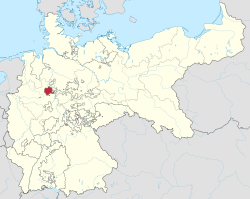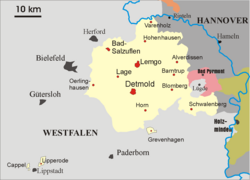Principality of Lippe Fürstentum Lippe (German) | |||||||||
|---|---|---|---|---|---|---|---|---|---|
| 1789–1918 | |||||||||
 The Principality of Lippe within the German Empire | |||||||||
 The Principality of Lippe in 1918 | |||||||||
| Status | State of the Holy Roman Empire (1789–1806) State of the Confederation of the Rhine (1806–1813) State of the German Confederation (1815–1866) State of the North German Confederation (1867–1871) Federated State of the German Empire (1871–1918) | ||||||||
| Capital | Detmold | ||||||||
| Common languages | West Low German | ||||||||
| Religion | Church of Lippe | ||||||||
| Government | Principality | ||||||||
| Prince | |||||||||
• 1789–1802 | Leopold I (first) | ||||||||
• 1905–1918 | Leopold IV (last) | ||||||||
| History | |||||||||
• Raised to Principality | 1789 | ||||||||
• German Revolution | 12 November 1918 | ||||||||
| Area | |||||||||
| 1910 | 1,215 km2 (469 sq mi) | ||||||||
| Population | |||||||||
• 1910 | 150,000+ | ||||||||
| |||||||||
Lippe (later Lippe-Detmold and then again Lippe) was a state in Germany, ruled by the House of Lippe. It was located between the Weser river and the southeast part of the Teutoburg Forest. It originated as a state during the Holy Roman Empire, and was promoted to the status of principality in 1789. During this period the ruling house split into a number of branches, with the main line residing at Detmold. During the Reformation, Lippe had converted to Lutheranism in 1538 and then to Calvinism in 1604.
From the demise of the empire in 1806, the principality was independent, but it joined the North German Confederation in 1866 and became one of the States of the German Empire in 1871. Over the course of the nineteenth century it gradually developed into a constitutional monarchy with moderate participation in government for the landed nobility. Its economy was overwhelmingly agrarian and among the weakest in the German Empire. After the last prince abdicated in 1918, it continued as a Free State of Germany until it was merged into North Rhine-Westphalia in 1947.

